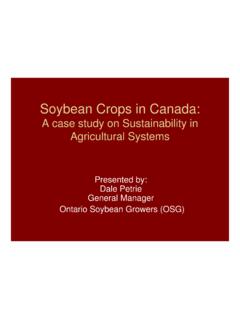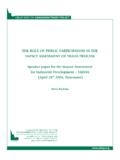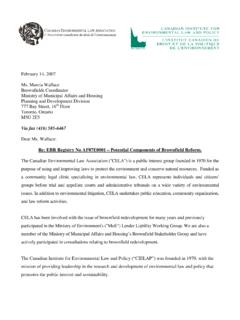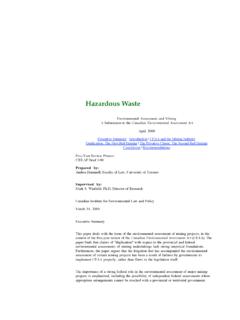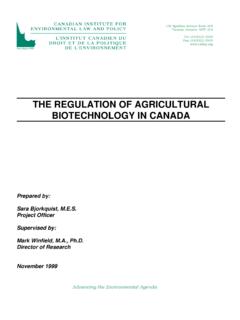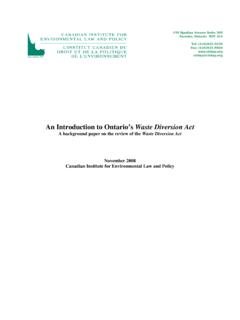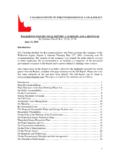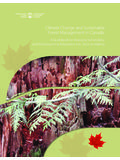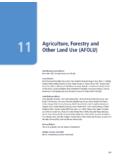Transcription of Greening Stormwater Management in Ontario - CIELAP.org
1 Greening Stormwater Management in Ontario An Analysis of Challenges and Opportunities Greening Stormwater Management in Ontario : An Analysis of Challenges and Opportunities by Matt Binstock Canadian Institute for Environmental Law and Policy June 2011. Acknowledgements About CIELAP. The Canadian Institute for Environmental Law Founded in 1970, the Canadian Institute for and Policy (CIELAP) would like to thank all of the Environmental Law and Policy (CIELAP) is an various participants in this study who independent, not-for-profit professional committed their time to being interviewed and research and educational institute committed to providing information. to environmental law and policy analysis and reform. CIELAP is incorporated under the laws CIELAP would also like to thank Noah Sokol and of the Province of Ontario and registered with Laura Anonen for research assistance in Revenue canada as a charitable organization.
2 Preparing this report. Our registration number is 11883 3417 RR0001. We would also like to sincerely thank The CIELAP informs legislative, policy and regulatory McLean Foundation for their financial outcomes for Sustainability at the national and assistance. provincial/territorial levels of government in canada . Copyright 2011 Canadian Institute for About the Author Environmental Law and Policy. Matt Binstock is a Policy Researcher at CIELAP. ISBN # 978-1-896588-72-8 Matt holds a Bachelors Degree in Environmental and Resource Studies from Trent University and a Masters Degree in Environmental Studies from York University. This publication can be downloaded from our website at Table of Contents Executive i Why Use Green Infrastructure in Ontario ?.. 1. Current Status of Green Infrastructure in Ontario .. 4. Policy and Legislative Tools to Promote Green Infrastructure in Ontario : Opportunities and 5. Ontario Water Resources Act and Tools for Stormwater 5.
3 Lake Simcoe Protection 7. Source Water Protection Planning and the Clean Water Act .. 9. canada - Ontario Agreement Respecting the Great Lakes Basin Ecosystem .. 9. Planning Act .. 9. Provincial Policy Statement ..10. Oak Ridges Moraine Conservation Water Opportunities and Water Conservation Act ..12. Building Code ..12. Ontario 's Growth Plan for the Greater Golden Horseshoe Region ..12. Infrastructure The Federal Gas Tax Fund ..13. Federation of Canadian Municipalities Green Municipal Fund ..13. Discussion .. 13. Use of Green Infrastructure in Other United States ..15. United Kingdom ..24. Analysis and Recommendations for Ontario ..29. Executive Summary This report assesses the current state of green infrastructure use for Stormwater Management in Ontario and makes recommendations for how the use of green infrastructure could be increased. In recent years, there has been a growing interest in the use of green infrastructure as an alternative to relying mainly on traditional approaches that focus on the conveyance of Stormwater , through pipes, to Stormwater ponds and outfalls that discharge into water bodies.
4 Green infrastructure may also help to reduce the severity of combined sewer overflows, which are a significant source of water pollution in the province. In addition, green infrastructure, where carefully planned and regularly maintained, may provide a no-regrets solution to climate change adaptation that could both help manage Stormwater and provide other benefits such as reducing the urban heat island effect. This report focuses on ways in which green infrastructure could be promoted at the provincial and federal levels through policy, legislation or financial assistance. While a number of Ontario municipalities have experimented with green infrastructure, there is still significant room to make further use of this technology in the province. In the Lake Simcoe Watershed, where green infrastructure is receiving serious consideration as a way to reduce phosphorus loading to Lake Simcoe, a number of barriers to using green infrastructure have been identified.
5 Key barriers include a lack of familiarity with green infrastructure, uncertainties surrounding its performance and apprehension arising from maintenance issues. It is likely that these concerns will remain a barrier to more widespread use of green infrastructure in the province until a substantial database is available that can provide assurances of expected performance from different forms of green infrastructure across a wide variety of regions. Such a database should also provide instruction on which technologies are best suited to the region based on topography, soil characteristics and other environmental factors. Based on the jurisdictional review conducted for this study, an effective approach to overcoming initial barriers to green infrastructure use would be to remove some of the risk for municipalities by funding pilot projects across the province that would in turn generate regionally specific performance data to encourage additional projects.
6 Illinois' experience with promoting green infrastructure suggests that providing grants to municipalities can be an effective means of getting past initial hesitation to experiment with new technologies. In both Washington and Maryland, substantial amounts of funding are being distributed by the state to aid municipalities in implementing green infrastructure for Stormwater Management . Funding for new projects plays an important role in reducing stigma and generating localized, specific performance data to convince municipalities and approval authorities that green infrastructure is viable. Over time though, the experiences of other jurisdictions suggest that more stringent requirements may be necessary to ensure that green infrastructure is implemented on a large scale across the province. In 3 of the 4 jurisdictions studied, a shift toward legislative requirements for green infrastructure is currently underway or has been recently completed.
7 I Why Use Green Infrastructure in Ontario ? In recent years there has been a growing interest in using green infrastructure as an alternative to the existing Stormwater Management approach, in which Stormwater is captured in storm sewers, conveyed through pipes and eventually discharged into receiving water bodies. Green infrastructure, for the purpose of this report, is defined as ecological processes or structures, whether natural or engineered, that process, capture and direct water, Stormwater and wastewater in a similar manner to grey infrastructure, yet have multiple ancillary societal benefits. 1 Different jurisdictions use various terms to describe green infrastructure, such as Low Impact Development, Sustainable Urban Drainage Systems, or Environmental Site Design. In this report, these various terms are used interchangeably throughout. Green infrastructure can include engineered solutions such as green roofs and green walls, permeable pavement, rain Curb extension with bioswale photo barrels, cisterns and constructed wetlands.
8 In a broader courtesy of Greg Raisman local or regional context, green infrastructure may also refer to existing natural features, such as wetlands, urban forests or parklands, that perform some degree of Stormwater retention and filtration. While none of the technologies currently being described as green infrastructure are new (some of them have been experimented with since the 1970s and 1980s), green infrastructure has increasingly been seen as a way of addressing urgent concerns in Ontario in recent years, including climate change and the need for new infrastructure investment. Green infrastructure is being discussed as a means to reduce the impact of potential flooding that may result from more intense storm and rainfall events anticipated in a changing global climate . Two major storm events that occurred during the past decade in Peterborough, Ontario in 2004 and North Toronto in 2005 have raised awareness of how such impacts of climate change could impact infrastructure.
9 Both events resulted in substantial financial costs related to infrastructure repair and individual property damage. Additional pressure on sewer systems will result in increased water pollution for municipalities that rely on combined sewers, through which storm drains connect to sanitary sewer lines and discharge into water bodies when line capacity is exceeded. Ontario has as many as 107 combined sewer systems located in 89 municipalities across the province. An investigative report published in 2009 revealed more than 1,000 instances of partially treated or raw sewage from combined sewers being discharged 1. Canadian Environmental Law Association and Ecojustice Submission to the Standing Committee on General Government: Recommendations Regarding Bill 72 (October 12, 2010). 1. into receiving waters in both 2006 and 2007. The authors noted that there may be even more instances of combined sewer overflows for which there are no records.
10 2. In a 2009 report entitled Adapting to climate change in Ontario , the Ontario Expert Panel on climate change Adaptation recommended that Ontario complete a comprehensive review of Stormwater Management practices throughout the province by the end of 2011. The panel recommended that the Ministry of Environment (MOE) ensure provisions for climate change adaptation are implemented into the provincial Stormwater Management framework. Furthermore, the panel recommended that the MOE update its 2003 Stormwater Management Planning and Design Manual in order to provide better support for innovative, multi-barrier approaches to Stormwater Management . 3 Green infrastructure is an ideal candidate for inclusion in a multi-barrier approach to Stormwater Management , particularly in light of the impacts of a changing global climate . Green infrastructure has the potential to capture larger amounts of rainfall before it enters a storm drain, reducing the frequency and intensity of combined sewer While green infrastructure will not replace traditional Stormwater Management facilities and may not capture the largest storm events, its role as a potential complementary measure is gradually gaining recognition in the province.

